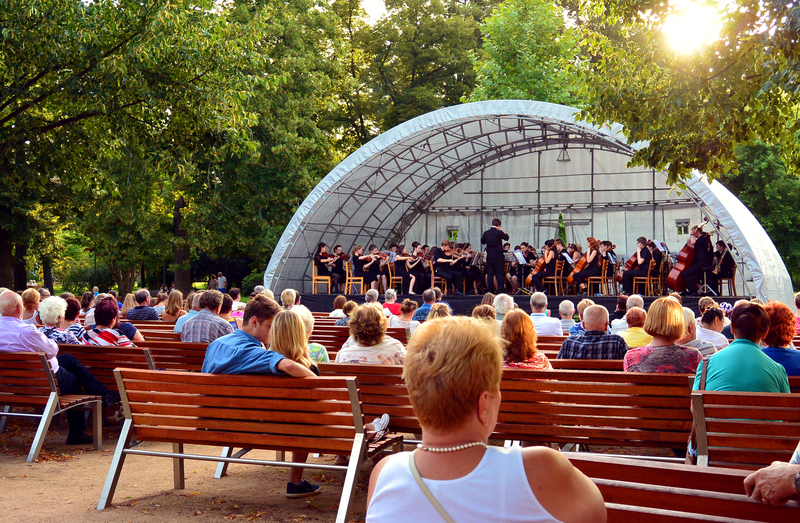
Community amenities that promote human interactions can be a boost for local businesses and contribute to regional economic growth. Credit: Anna Brothankova|Dreamstime.com.
A bandshell for outdoor concerts in Ashwaubenon; an art-filled event space in downtown Dodgeville; a community park for hosting Lena’s farmers markets. These are examples of recently funded projects for promoting Wisconsin’s economic development by creating vibrant places. They are designed for people to gather and interact in order to instill a sense of belonging and pride.
Enhancing community livability is different from what economic development practitioners used to focus on: attracting companies through tax incentives. The common belief was that “people follow jobs” after regional employment opportunities had been created.
But desirable amenities that attract people can also promote business development. In this “jobs follow people” model, existing residents become future clients, employees and business owners. “Communities are shifting their focus from jobs to people by emphasizing quality of life,” says AAE professor Steve Deller. “I’m calling this the fourth wave of economic development strategies.”
An early example of first-wave programs is Mississippi, where agriculture was the dominant industry for decades. To counter the devastating effects of the Great Depression, state leaders passed the “Balance Agriculture with Industry” legislation in 1936. Its goal was to attract Northern manufacturing companies with tax incentives and lower costs of land and labor. Although this approach created new jobs, there is limited evidence that it fundamentally strengthened the Mississippi economy
More successful examples of first-wave strategies include Kentucky and South Carolina. In 1986 and 1992, they enticed Toyota and BMW to build their first U.S. manufacturing plants in Georgetown and Spartanburg, respectively. Both efforts created regional hubs of sustained economic activity. Wisconsin’s failed attempt to attract Foxconn to Racine County in 2017, however, illustrates that policies focused on financial incentives no longer work well.
The second wave of economic development strategies emerged in the early 1980s with the recognition that small businesses were driving national job growth more than large manufacturing companies. Thus, economic development practitioners began to support small-scale entrepreneurship. This included both the formation of new businesses and the retention and expansion of existing ones.
A more strategic third wave started in the 2000s when the U.S. Department of Commerce encouraged communities to promote industry clusters in areas of existing strength. In Wisconsin, this included tourism and recreation as well as the dairy, paper and other manufacturing industries.
“Thinking about economic clusters also helped communities realize that they are part of a larger regional economy,” says Deller. “Instead of competing against each other, they created regional collaborations including both public and private sectors.” Examples that formed in 2005 include the M7 public-private partnership in the Milwaukee region and New North Inc. in northern Wisconsin.
The second and third waves began to move away from “top-down” state-led efforts toward “bottom-up” community-driven strategies but still emphasized businesses and the jobs they provide. In contrast, the fourth wave describes what planners refer to as placemaking, or the creation of “quality places that people want to live, work, play and learn in.” It recognizes that quality of life means different things for different people, empowering both urban and rural communities to define what prosperity and livability mean for their own region.
This approach is the foundation of the Rural Livability project led by Deller’s colleague Tessa Conroy. It motivated AAE PhD student Mckenzie Boyce to explore the concept of livability from an economist’s perspective. She is modeling household relocation decisions to estimate two indices for all U.S. counties: stickiness, or the ability to retain existing residents; and quality of life, or the ability to attract new residents.

“Once I know from migration flows which places attract and retain people, I can evaluate the county features that are associated with those two indices,” explains Boyce, noting that some factors may be positively correlated with quality of life and negatively correlated with stickiness, or vice versa. Example features include schools, healthcare and childcare facilities, libraries and recreational opportunities. “These amenities aren’t always viewed as economic development strategies, but they allow people to prosper in their own life, which helps build successful communities,” says Boyce.
Fourth-wave strategies leverage the growing demand for work flexibility that started with the pandemic, often in the form of remote work. Since many remote workers can choose where to make their home, they prioritize a community’s livability and have a high willingness to pay for broadband access, as Boyce reported in a study that earned an award from the Agricultural and Applied Economics Association. Regions that attract remote workers also provide new opportunities for entrepreneurship, with residents creating business models that match the communities they live in.
In arguing for the fourth wave of economic development, Deller examined if and how the balance between “jobs follow people” and “people follow jobs” has evolved over time. He analyzed changes in population and employment numbers during five decades (1970 to 2020) in more than 3,100 U.S. counties.
The shift from a focus on jobs toward a focus on people was not as strong as he expected, but jobs followed people in more counties in the 2010s than in the 1970s. “My results confirmed large regional variation, meaning the local context always matters greatly,” says Deller. “It’s not black and white, it’s shades of gray: What may be best for one community may not be appropriate for another.”
Similarly, economic development practitioners should not replace one wave of thinking with another by abandoning efforts to promote business growth. Instead, Deller suggests striking a balance between focusing on people and firms. “Cold calls asking if large firms would like to open a branch in your community are not an efficient strategy,” says Deller. “But if one of those companies comes knocking at your door, be ready with a good response.”